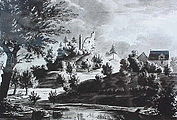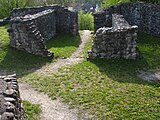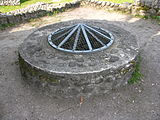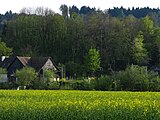Alt-Regensberg ruins
| Alt-Regensberg | ||
|---|---|---|
|
The castle hill from the northeast |
||
| Alternative name (s): | Altburg | |
| Creation time : | around 1040 | |
| Castle type : | Niederungsburg | |
| Conservation status: | Ruin, preserved wall remains | |
| Standing position : | Free nobles | |
| Place: | Regensdorf | |
| Geographical location | 47 ° 25 '42.9 " N , 8 ° 28' 55.3" O | |
| Height: | 466 m above sea level M. | |
|
|
||
The Alt-Regensberg ruins are the ruins of a Niederungsburg near Regensdorf in the Dielsdorf district of the Swiss canton of Zurich .
history
High Middle Ages
The castle goes back to the noble Lütold von Affoltern and was probably built as the ancestral seat of the Lords of Regensberg around 1040. It is not known exactly where the Regensbergers originally came from. It is believed that they were settled in the Mâcon area . The Regensberg dynasty was very powerful and its possessions were widely scattered. The Regensbergers were among other things the founders of the monasteries Fahr and Rüti and the cities of Regensberg and Glanzenberg .
Around 1050, the Regensbergers were responsible for the ecclesiastical needs of the population and built the St. Niklaus chapel as a parish church in Oberregensdorf, by far the oldest building in the Regensdorf community and at the same time one of the oldest ecclesiastical buildings in the canton of Zurich.
Lütold I, the son of Lütold von Affoltern, began to call himself Alt-Regensberg after the castle and died in 1088 in a fight against the abbot of the St. Gallen monastery .
Finally, Lütold IV had already expanded his position of power to such an extent that he could call himself Count von Regensberg from the early 13th century. At that time he owned goods and rights in large parts of the Zürichgau, Thurgau , Klettgau and far into the Aargau . The old family seat has now been significantly expanded to a stone Bering , a cistern and new economic structures. The tower of Alt-Regensberg Castle was also redesigned with carefully hewn boss blocks .
Decline of the Regensbergers
After the death of Lütold V (around 1250), his two sons, Lütold VI. and Ulrich von Regensberg, the legacy. Ulrich received the castle town of Neu-Regensberg and property in the area of Glanzenberg, Fahr and Weiningen. Ulrich resided from then on in Neu-Regensberg, his brother Lütold VI. in Alt-Regensberg. A long series of sales and pledges began, without which the family apparently could not maintain their lifestyle. In the two decades after Ulrich and Lütold VI. The Regensberg feud of 1267/68, which has only survived in fragments and ended with the economic decline of the Regensbergs and the sale of the properties to Habsburg lords, falls .
The last secular representative, Lütold IX, probably lived in the family castle Alt-Regensberg. In 1321, Lütold IX. issued a certificate for the last time on Alt-Regensberg. He died around ten years later as the last male representative of the family. The relocation of the Habsburg center of power to Austria is reflected in the repeated pledges of Regensberg.
When the Regensbergers in the male line with Lütold IX around 1331. died out, the castle came into the possession of the Lords of Landenberg - Greifensee in 1350 . In 1444, the last representative of the Landenbergs handed the castle over to the Confederates during the Old Zurich War . They probably didn't spare them. When the complex was bought by the wealthy Zurich merchant and textile merchant Rudolf Mötteli in 1458, he completely renovated it, but left the structure as it was. Due to a dispute with the city of Zurich, Mötteli was expropriated by the Zurich authorities as early as 1468.
Zurich saw no use for the facility, neither for military nor for administrative purposes. Therefore it gradually fell into disrepair and was used as a quarry. In 1705 the Regensdorfer got building materials for the new church from the Altburg, in 1775 the bridge of Adlikon was built from its stones. The ruins came into the possession of the Canton of Zurich from the city in Helvetic Republic . However, their slopes remained private and served as vineyards . Their owners considered demolishing the curtain wall , as falling stones bothered them. A protection ordinance saved the ruins and at the beginning of the 20th century the Altburg was preserved in its current form.
photos
The castle ruins on a watercolor by Ludwig Schulthess
literature
- Thomas Bitterli-Waldvogel: Swiss Castle Guide - Including the Principality of Liechtenstein . Friedrich Reinhardt Verlag, Basel / Berlin 1995, ISBN 3-7245-0865-4 .
- Werner Meyer and Laslo Irmes (photos): Castles of Switzerland, Volume 5: Cantons of Zurich and Schaffhausen . Silva-Verlag, Zurich 1982.
- Hugo Schneider: The Alt-Regensberg castle ruins: Report on the research 1955-57 (Swiss contributions to the cultural history and archeology of the Middle Ages, Vol. 6), Olten / Freiburg i.Br. 1979.
- Fritz Hauswirth: Castles and Palaces of Switzerland , Vol. 4: Zurich, Schaffhausen, Kreuzlingen 1968.
- Emil Stauber: The castles and noble families of the districts of Zurich, Affoltern and Horgen , Basel 1955.
- Heinrich Zeller-Werdmüller: Zurich castles . In: Communications from the Antiquarian Society in Zurich , 48./49. Born in Zurich 1894–1895.
Web links
- Alt-Regensberg ruins on the ETHorama platform
- Castle world: Alt-Regensberg
- Archive link: Alt-Regensberg on burgen.ch ( Memento from September 23, 2012 in the Internet Archive )
- Alt-Regensberg at swisscastles.ch
Individual evidence
- ^ Website Evangelical Reformed Church Community Regensdorf ( Memento from September 20, 2010 in the Internet Archive )
- ↑ a b Website dickemauern.de, Burg Alt-Regensberg (as of March 28, 2008)
- ↑ a b Website swisscastles.ch, Castles of Zurich, Regensberg (as of March 28, 2008)











